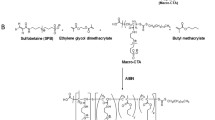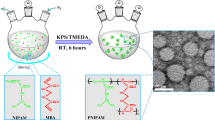Abstract
We present an investigation of horseradish peroxidase (HRP)/H2O2-mediated crosslinking in an inverse miniemulsion for the successful preparation of a stable colloidal nanogel from a poly(amino acid)-based polymer precursor. The precursor was obtained by the aminolysis of polysuccinimide with aminoethan-2-ol and tyramine, resulting in a poly(α,β-N-(2-hydroxyethyl)-D,L-aspartamide-co-N-(2-(4-hydroxyphenyl)ethyl)-D,L-aspartamide) polymer (PHEA-Tyr). Various concentrations of the PHEA-Tyr in aqueous solution with HRP were emulsified in the presence of cyclohexane and SPAN 80. The addition of a hydrogen peroxide solution induced crosslinking between the polymer chains via the phenol groups (Tyr) and targeted nanogel formation. The hydrodynamic radii (R h 0), mean size documented by hydrodynamic radius (R h ), and morphology of the nanoparticles were investigated by dynamic light scattering (DLS) measurements, nanoparticle tracking analysis (NTA), and cryogenic transmission electron microscopy (cryo-TEM). It was found out that nanoparticle radius, morphology, and architecture of the nanogel could be regulated by the initial concentration of the precursor.




Similar content being viewed by others
References
Vinogradov S, Batrakova E, Kabanov A (1999) Poly(ethylene glycol)−polyethyleneimine nanogel™ particles: novel drug delivery systems for antisense oligonucleotides. Colloid Surf B 16:291–304
Soni KS, Desale SS, Bronich TK (2016) Nanogels: an overview of properties, biomedical applications and obstacles to clinical translation. J Control Release 240:109–126
Zhang X, Malhotra S, Molina M, Haag R (2015) Micro- and nanogels with labile crosslinks—from synthesis to biomedical applications. Chem Soc Rev 44:1948–1973
Iwasaki Y, Kondo JI, Kuzuya A, Moriyama R (2016) Crosslinked duplex DNA nanogels that target specified proteins. Sci Technol Adv Mat 17:285–292
Pujana MA, Pérez-Álvarez L, Iturbe LCC, Katime I (2012) Water dispersible pH-responsive chitosan nanogels modified with biocompatible crosslinking-agents. Polymer 53:3107–3116
Singh S, Möller M, Pich A (2013) Biohybrid nanogels. J Polym Sci Pol Chem 51:3044–3057
Neamtu I, Rusu AG, Diaconu A, Nita LE, Chiriac AP (2017) Basic concepts and recent advances in nanogels as carriers for medical application. Drug Deliv 24:539–557
Meléndez-Ortiz HI, Peralta RD, Bucio E, Zerrweck-Maldonado L (2014) Preparation of stimuli-responsive nanogels of poly[2-(dimethylamino) ethyl methacrylate] by heterophase and microemulsion polymerization using gamma radiation. Polym Eng Sci 54:1625–1631
Oh JK, Siegwart DJ, Lee HI, Sherwood G, Peteanu L, Hollinger JO, Kataoka K, Matyjaszewski K (2007) Biodegradable nanogels prepared by atom transfer radical polymerization as potential drug delivery carriers: synthesis, biodegradation, in vitro release, and bioconjugation. J Am Chem Soc 129:5939–5945
Oh JK, Bencherif SA, Matyjaszewski K (2009a) Atom transfer radical polymerization in inverse miniemulsion: a versatile route toward preparation and functionalization of microgels/nanogels for targeted drug delivery applications. Polymer 50:4407–4423
Bhuchar N, Sunasee R, Ishihara K, Thundat T, Narain R (2012) Degradable thermoresponsive nanogels for protein encapsulation and controlled release. Bioconjug Chem 23:75–83
Averick SE, Magenau AJD, Simakova A, Woodman BF, Seong A, Mehl RA, Matyjaszewski K (2011) Covalently incorporated protein-nanogels using AGET ATRP in an inverse miniemulsion. Polym Chem 2:1476–1478
Oh JK, Lee DI, Park JM (2009b) Biopolymer-based microgels/nanogels for drug delivery applications. Prog Polym Sci 34:1261–1282
Klinger D, Landfester K (2011) Dual stimuli-responsive poly(2-hydroxyethyl methacrylate-co-methacrylic acid) microgels based on photo-cleavable cross-linkers: pH-dependent swelling and light-induced degradation. Macromolecules 44:9758–9772
McAllister K, Sazani P, Adam M, Cho MJ, Rubinstein M, Samulski RJ, DeSimone JM (2002) Polymeric nanogels produced via inversion microemulsion polymerization as potential gene and antisense delivery agents. J Am Chem Soc 124:15198–15207
Sanson N, Rieger J (2010) Synthesis of nanogels/microgels by conventional and controlled radical crosslinking copolymerization. Polym Chem 1:965–977
Yildrim T, Rinkenauer AC, Weber C, Traeger A, Schubert S, Schubert US (2015) RAFT made methacrylate copolymers for reversible pH-responsive nanoparticles. J Polym Sci Pol Chem 53:2711–2721
Gao H, Matyjaszewski K (2008) Synthesis of star polymers by a new “core-first” method: sequential polymerization of cross-linker and monomer. Macromolecules 41:1118–1125
Bencherif SA, Washburn NR, Matyjaszewski K (2009) Synthesis by AGET ATRP of degradable nanogel precursors for in situ formation of nanostructured hyaluronic acid hydrogel. Biomacromolecules 10:2499–2507
Graff RW, Shi Y, Wang X, Gao H (2009) Comparison of loading efficiency between hyperbranched polymers and cross-linked nanogels at various branching densities. Macromol Rapid Commun 36:2076–2082
Landfester K, Willert M, Antonietti M (2000) Preparation of polymer particles in nonaqueous direct and inverse miniemulsions. Macromolecules 33:2370–2376
Capek I (2010) On inverse miniemulsion polymerization of conventional water-soluble monomers. Adv Colloid Interf Sci 156:35–61
Dou XQ, Feng CL (2017) Amino acids and peptide-based supramolecular hydrogels for three-dimensional cell culture. Adv Mater 29:1604062
Svobodová J, Proks V, Karabiyik Ö, Koyuncu ACÇ, Köse GT, Rypáček F, Studenovská H (2017) Poly(amino acid)-based fibrous scaffolds modified with surface-pendant peptides for cartilage tissue engineering. J Tissue Eng Regen Med 11:831–842
Park CW, Yang HM, Woo MA, Lee KS, Kim JD (2017) Completely disintegrable redox-responsive poly(amino acid) nanogels for intracellular drug delivery. J Ind Eng Chem 45:182–188
Wu DQ, Cui HC, Zhu J, Qin XH, Tie T (2016) Novel amino acid based nanogel conjugated suture for antibacterial application. J Mater Chem B 4:2606–2613
Pitarresi G, Tomarchio V, Cavallaro G, Giammona G (1996) α,β-poly(N-hydroxy)-DL-aspartamide hydrogels as drug delivery devices. J Bioact Compat Polym 11:328–340
Giammona G, Pitarresi G, Tomarchio V, Cacciaguerra S, Govoni P (1997) A hydrogel based on a polyaspartamide: characterization and evaluation of in-vivo biocompatibility and drug release in the rat. J Pharm Pharmacol 49:1051–1056
Mandracchia D, Pitarresi G, Palumbo FS, Carlisi B, Giammona G (2004) pH-sensitive hydrogel based on a novel photocross-linkable copolymer. Biomacromolecules 5:1973–1982
Rypáček F, Drobnik J, Chmelař V, Kálal J (1982) The renal excretion and retention of macromolecules. The chemical structure effect. Pflügers Arch 392:211–217
Bae JW, Choi JH, Lee Y, Park D (2015) Horseradish peroxidase-catalysed in situ-forming hydrogels for tissue-engineering applications. J Tissue Eng Regen Med 9:1225–1232
Neri P, Antoni G, Benvenuti F, Cocola F, Gazzei G (1973) Synthesis of α,β-poly [(2-hydroxyethyl)-DL-aspartamide], a new plasma expander. J Med Chem 16:893–897
Jakeš J (1995) Regularized positive exponential sum (REPES) program—a way of inverting Laplace transform data obtained by dynamic light scattering. Collect Czechoslov Chem Commun 60:1781–1797
Cavallaro G, Pitarresi G, Giammona G (2004) Advanced biomaterials for medical applications. Kluwer Academic Publishers, Dordrecht
Coviello T, Yuguchi Y, Kajiwara K, Giammona G, Cavallaro G, Alhaique F, Palleschi A (1998) Conformational analysis of α,β-poly(N-hydroxyethyl)-DL-aspartamide (PHEA) and α,β-polyasparthydrazide (PAHy) polymers in aqueous solution. Polymer 39:4159–4164
Jansen TGT, Meuldijk J, Lovell PA, van Herk AM (2016) On the miniemulsion polymerization of very hydrophobic monomers initiated by a completely water-insoluble initiators: thermodynamics, kinetics, and mechanism. J Polym Sci Polym Chem 54:2731–2745
Filipe V, Hawe A, Jiskoot W (2010) Critical evaluation of nanoparticle tracking analysis (NTA) by NanoSight for the measurement of nanoparticles and protein aggregates. Pharm Res 27:796–810
Gonzáles de Torre I, Quintanilla L, Pinedo-Martín G, Alonso M, Rodríguez-Cabello JC (2014) Nanogel formation from dilute solutions of clickable elastine-like recombinamers and its dependence on temperature: two fractal gelation modes. ACS Appl Mater Interfaces 6:14509–14515
Wang R, Xu DI, Liang L, Xu TT, Liu W, Ouyang PK, Chi B, Xu H (2016) Enzymatically crosslinked epsilon-poly-L-lysine hydrogels with inherent antibacterial properties for wound infection prevention. RSC Adv 6:8620–8627
Koul V, Mohamed R, Kuckling D, Adler HJP, Choudhary V (2011) Interpenetrating polymer network (IPN) nanogels based on gelatin and poly(acrylic acid) by inverse miniemulsion technique: synthesis and characterization. Colloid Surf B 83:204–213
Wu C, Böttcher C, Haag R (2015) Enzymatically crosslinked dendritic polyglycerol nanogels for encapsulation of catalytically active proteins. Soft Matter 11:972–980
Author information
Authors and Affiliations
Corresponding author
Ethics declarations
Financial support from the Czech Science Foundation (No. 16-02702S) is gratefully acknowledged.
Compliance with ethical standards
ᅟ
Conflict of interest
The authors declare that they have no competing interest.
Rights and permissions
About this article
Cite this article
Petr, Š., Jana, D., Peter, Č. et al. Poly(amino acid)-based nanogel by horseradish peroxidase catalyzed crosslinking in an inverse miniemulsion. Colloid Polym Sci 296, 995–1003 (2018). https://doi.org/10.1007/s00396-018-4318-7
Received:
Revised:
Accepted:
Published:
Issue Date:
DOI: https://doi.org/10.1007/s00396-018-4318-7




